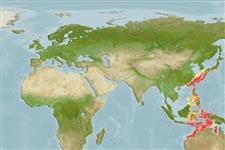>
Perciformes/Uranoscopoidei (Sand dwellers) >
Ammodytidae (Sand lances)
Etymology: Bleekeria: He researched the fishes from India and Malaysia, 1862-1878 (Ref. 45335); mitsukurii: Although not specified in the original description, the specific epithet "mitsukurii" is honouring Kakichi Mitsukuri (1857-1909) zoologist and professor at the Imperial University of Tokyo..
More on authors: Jordan & Evermann.
Environment: milieu / climate zone / depth range / distribution range
Ecología
marino bentopelágico; rango de profundidad 56 - 217 m (Ref. 86942). Tropical; 36°N - 21°S, 116°E - 140°E (Ref. 57360)
Indo-Pacific: central Japan to the South China Sea. Recorded from Indonesia and northwestern Australia (Ref. 5978) and from the Chesterfield Islands (Ref. 11897); also occurs in the western Indian Ocean (Ref. 7068).
Tamaño / Peso / Age
Maturity: Lm ? range ? - ? cm
Max length : 16.0 cm TL macho / no sexado; (Ref. 637)
Radios blandos dorsales (total): 37-42; Radios blandos anales: 14 - 16; Vértebra: 50 - 56. This species is distinguished by having teeth in jaws; scales on central part of body of equal length and height; when fresh caudal fin colouration dusky with black-edged yellow inner margin (Ref. 123825).
Schools in shallow waters on sandy bottom, diving into the sand when threatened (Ref. 637). Probably taken by trawl net and handnet (Ref. 123825).
Life cycle and mating behavior
Madurez | Reproducción | Puesta | Huevos | Fecundidad | Larva
Collette, B.B., 2001. Ammodytidae. Sandlances. p. 3518. In K.E. Carpenter and V. Niem (eds.) FAO species identification guide for fishery purposes. The living marine resources of the Western Central Pacific. Vol. 6. Bony fishes part 4 (Labridae to Latimeriidae), estuarine crocodiles. FAO, Rome. (Ref. 10275)
IUCN Red List Status (Ref. 130435)
Threat to humans
Harmless
Human uses
Más información
Nombres comunesSinónimosMetabolismoDespredadoresEcotoxicologíaReproducciónMadurezPuestaAgregación para la puestaFecundidadHuevosEgg development
ReferenciasAcuiculturaPerfil de acuiculturaRazasGenéticaElectrophoresesheritabilidadEnfermedadesProcesamientoNutrientsMass conversion
ColaboradoresImágenesStamps, Coins Misc.SonidosCiguateraVelocidadTipo de nataciónSuperficie branquialOtolitosCerebrosVisión
Herramientas
Special reports
Download XML
Fuentes de Internet
Estimates based on models
Preferred temperature (Ref.
123201): 18.4 - 27.6, mean 24.4 °C (based on 190 cells).
Phylogenetic diversity index (Ref.
82804): PD
50 = 0.5156 [Uniqueness, from 0.5 = low to 2.0 = high].
Bayesian length-weight: a=0.00324 (0.00148 - 0.00706), b=3.10 (2.91 - 3.29), in cm total length, based on LWR estimates for this (Sub)family-body shape (Ref.
93245).
Nivel trófico (Ref.
69278): 3.2 ±0.4 se; based on size and trophs of closest relatives
Resiliencia (Ref.
120179): Alto, población duplicada en un tiempo mínimo inferior a 15 meses (Preliminary K or Fecundity.).
Fishing Vulnerability (Ref.
59153): Low vulnerability (10 of 100).
